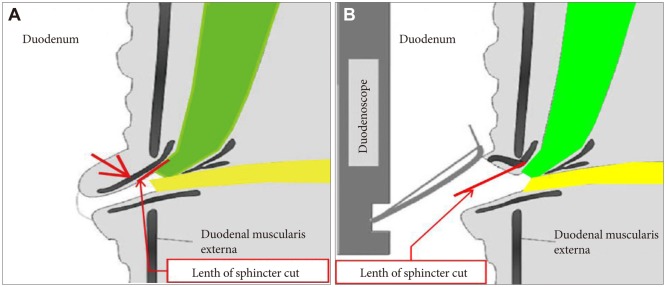Clin Endosc.
2015 Jan;48(1):20-23. 10.5946/ce.2015.48.1.20.
Burdick's Technique for Biliary Access Revisited
- Affiliations
-
- 1Institute of Gastro Sciences, Apollo Gleneagles Hospitals, Kolkata, India. vijayrai80@gmail.com
- KMID: 2221754
- DOI: http://doi.org/10.5946/ce.2015.48.1.20
Abstract
- The precut sphincterotomy is used to facilitate selective biliary access in cases of difficult biliary cannulation. Needle-knife precut papillotomy is the standard of care but is associated with a high rate of complications such as pancreatitis, duodenal perforation, bleeding, etc. Sometimes during bowing of the sphincterotome/cannula and the use of guide wire to facilitate biliary cannulation, inadvertent formation of a false passage occurs in the 10 to 11 o'clock direction. Use of this step to access the bile duct by the intramucosal incision technique was first described by Burdick et al., and since then two more studies have also substantiated the safety and efficacy of this non-needle type of precut sphincterotomy. In this review, we discuss this non-needle technique of precut sphincterotomy and also share our experience using this "Burdick's technique."
Keyword
Figure
Reference
-
1. Worthley CS, Toouli J. Endoscopic decompression for acute cholangitis due to stones. Aust N Z J Surg. 1990; 60:355–359. PMID: 2334359.
Article2. Mallery JS, Baron TH, Dominitz JA, et al. Complications of ERCP. Gastrointest Endosc. 2003; 57:633–638. PMID: 12709688.
Article3. Bailey AA, Bourke MJ, Williams SJ, et al. A prospective randomized trial of cannulation technique in ERCP: effects on technical success and post-ERCP pancreatitis. Endoscopy. 2008; 40:296–301. PMID: 18389448.
Article4. Rabenstein T, Schneider HT, Nicklas M, et al. Impact of skill and experience of the endoscopist on the outcome of endoscopic sphincterotomy techniques. Gastrointest Endosc. 1999; 50:628–636. PMID: 10536317.
Article5. Freeman ML, Guda NM. ERCP cannulation: a review of reported techniques. Gastrointest Endosc. 2005; 61:112–125. PMID: 15672074.
Article6. Freeman ML, Nelson DB, Sherman S, et al. Complications of endoscopic biliary sphincterotomy. N Engl J Med. 1996; 335:909–918. PMID: 8782497.
Article7. Kasmin FE, Cohen D, Batra S, Cohen SA, Siegel JH. Needle-knife sphincterotomy in a tertiary referral center: efficacy and complications. Gastrointest Endosc. 1996; 44:48–53. PMID: 8836716.
Article8. Desilets DJ, Howell DA. Precut sphincterotomy: another perspective on indications and techniques [Internet]. UpToDate;c2015. updated 2012 Nov 8. cited 2015 Jan 5. Available from: http://www.uptodateonline.com.9. Cotton PB. Precut papillotomy: a risky technique for experts only. Gastrointest Endosc. 1989; 35:578–579. PMID: 2599302.10. Larkin CJ, Huibregtse K. Precut sphincterotomy: indications, pitfalls, and complications. Curr Gastroenterol Rep. 2001; 3:147–153. PMID: 11276383.
Article11. Shakoor T, Geenen JE. Pre-cut papillotomy. Gastrointest Endosc. 1992; 38:623–627. PMID: 1397929.
Article12. Burdick JS, London A, Thompson DR. Intramural incision technique. Gastrointest Endosc. 2002; 55:425–427. PMID: 11868023.
Article13. Misra SP, Dwivedi M. Intramural incision technique: a useful and safe procedure for obtaining ductal access during ERCP. Gastrointest Endosc. 2008; 67:629–633. PMID: 17826775.
- Full Text Links
- Actions
-
Cited
- CITED
-
- Close
- Share
- Similar articles
-
- Endoscopic Ultrasound-Guided Biliary Access, with Focus on Technique and Practical Tips
- Articulated percutaneous plastic biliary stents: How to do it
- Safety and feasibility of opening window fistulotomy as a new precutting technique for primary biliary access in endoscopic retrograde cholangiopancreatography
- Endoscopic Guided Biliary Drainage: How Can We Achieve Efficient Biliary Drainage?
- Optimal Use of Wire-Assisted Techniques and Precut Sphincterotomy



